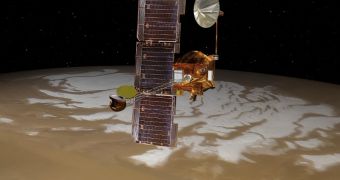On Tuesday, February 11, Mars Odyssey mission controllers moved the spacecraft to a new orbit around the Red Planet. The maneuver was carried out so that the orbiter could gain a new perspective on some very interesting atmospheric phenomena taking place over our neighboring world.
The move commends were developed and transmitted to the spacecraft by scientists at the NASA Jet Propulsion Laboratory (JPL) in Pasadena, California, and Lockheed Martin Space Systems in Denver, Colorado. The latter was one of the main contractors for building the vehicle.
Scientists say that the thruster firings accelerated the spacecraft's drift towards a morning-daylight orbit, which will enable Odyssey to observe morning fogs, clouds and surface frosts occurring on Mars. The long-term goal is to see how these phenomena change between seasons, the team explains.
The spacecraft will continue to drift towards its target orbit until November 2015. Once the correct coordinates are reached, a new engine firing will stop the drift, and stabilize Mars Odyssey on its new orbital perch. This position will enable new types of science from the orbiter, which has been surveying the Red Planet since 2001.
“We're teaching an old spacecraft new tricks. Odyssey will be in position to see Mars in a more different light from ever before,” explains Odyssey project scientist Jeffrey Plaut, who is based at JPL.
In November 2015, this spacecraft will become NASA's first-ever orbiter capable of observing the Martian surface in morning daylight. The orbits of all other satellites the space agency has deployed since the 1970s has made such observations impossible.
Spacecraft such as the NASA Mars Reconnaissance Orbiter and the European Space Agency's (ESA) Mars Express are occupying orbits that enable them to conduct observations of the surface in the afternoon, when less haze blocks their views of Mars.
“We don't know exactly what we're going to find when we get to an orbit where we see the morning just after sunrise. We can look for seasonal differences,” says Arizona State University investigator Philip Christensen.
“Are fogs more common in winter or spring? We will look systematically. We will observe clouds in visible light and check the temperature of the ground in infrared,” concludes the expert, who is the principal investigator of Odyssey's Thermal Emission Imaging System (THEMIS) instrument.

 14 DAY TRIAL //
14 DAY TRIAL //